Rex's FAD
Major arpeggio shapes
Now that we’ve looked at major triad shapes in isolation, let’s merge them into three six-string arpeggios:

Fig 1. C Major arpeggios
An arpeggio is just a “broken chord”. The individual notes in an arpeggio are played one at a time rather than simultaneously. As we’ve already established, any three adjacent strings within these arpeggios can be played as a chord.
I’ve given each of these three shapes a name: A shape, F shape, and D shape. The names are just so I have something to refer to in the documentation for this course, I try not to think about shape names when playing!
The following exercise will help you become intimately familiar with these major arpeggio shapes and how they interconnect.
TODO add major TDG test
CAGED
You’ve probably heard of the CAGED system before. It teaches five movable shapes (barre chords) based on the cowboy chords of the same name.
Here are the CAGED shapes for a C Major chord:
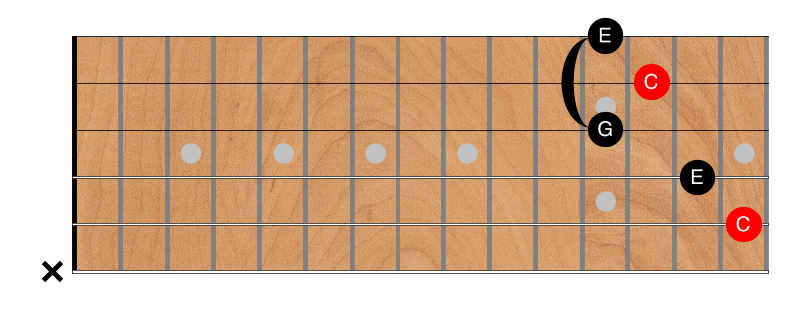
Fig 2. CAGED: C Major, C shape
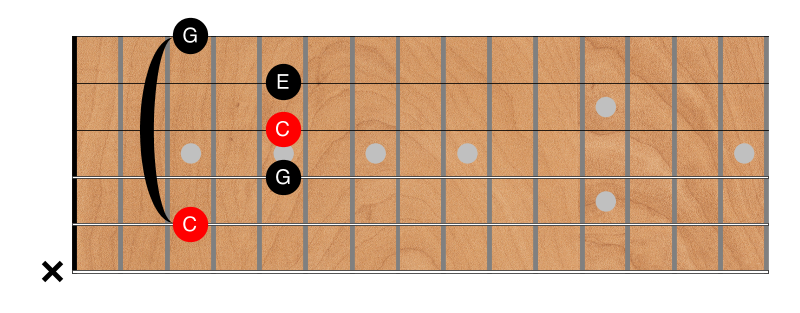
Fig 3. CAGED: C Major, A shape
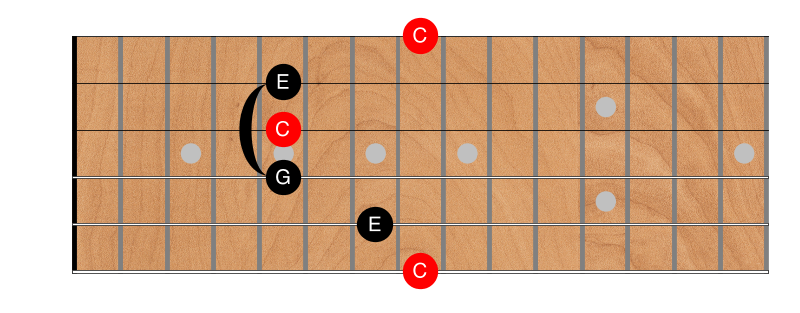
Fig 4. CAGED: C Major, G shape
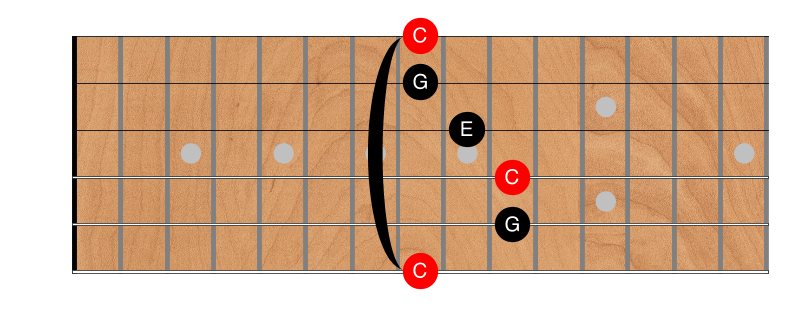
Fig 5. CAGED: C Major, E shape
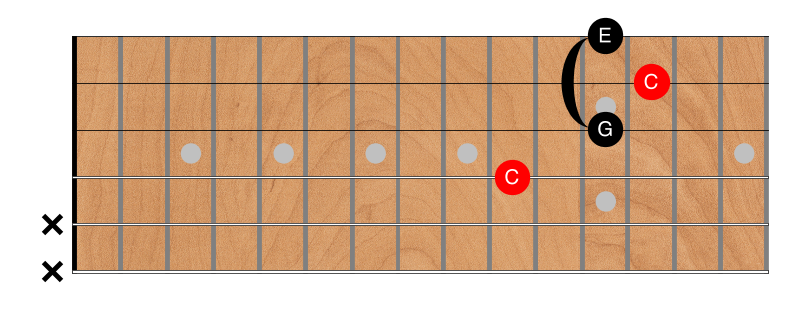
Fig 6. CAGED: C Major, D shape
Hopefully you can see how the three arpeggio shapes of figure 1 also include all five of the CAGED shapes (but grouped into three non-overlapping shapes rather than five that overlapped in different places).
My gripes with CAGED
CAGED has helped an uncountable number of players. There is nothing wrong with teaching CAGED, but, to my brain at least, it’s unnecessarily confusing:
The A and G shapes share a bunch of notes, as do the C and D shapes. Why name them and think about them as separate shapes?
Only contortionists can actually play the full D or G shapes from CAGED as chords — the fingerings are just too difficult!
- Most people just play the top four strings or bottom five strings of the G shape.
- Similarly, most people only play the lower three notes in the D shape. That’s not even C Major! Technically those three notes only form a C5 power chord since they don’t include the third.
- By way of contrast: any three adjacent strings in the arpeggios from figure 1 can be played is a full-fledged major chord.
In practice, CAGED tends to over-emphasize root notes on the E and A strings. Countless guitarists that practice CAGED struggle to find notes on anything other than the lowest two strings.
Lastly, with CAGED, I hated even thinking things like: “I’m playing an E shape B Major chord.” Wait, is it an E or a B? Way too confusing.
I find it far simpler to think in terms of the arpeggios in figure 1 — what I’m calling “Rex’s FAD”.
Rex’s FAD
What follows is one of the biggest epiphanies I’ve ever had on the guitar.
My brain struggled with five CAGED shapes. For some reason, those big five and six string shapes were just too much for my little pea brain.
Things became much easier when I did two things:
Focus mainly on the top four strings
Reduce the full six-string arpeggios from figure 1 to just the minimal internal triad “kernels” as shown below:
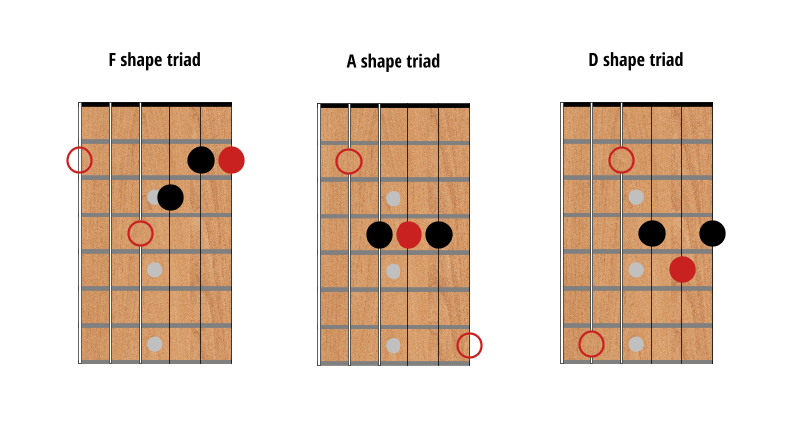
Fig 7. Rex's FAD: Three triads
The triad “kernels” of Rex’s FAD are shown with solid circles, alternate root locations are shown with hollow circles.
I only think about those three simple triad shapes when I try to locate things on the fretboard. For example, my brain “sees” figure 1 like this:
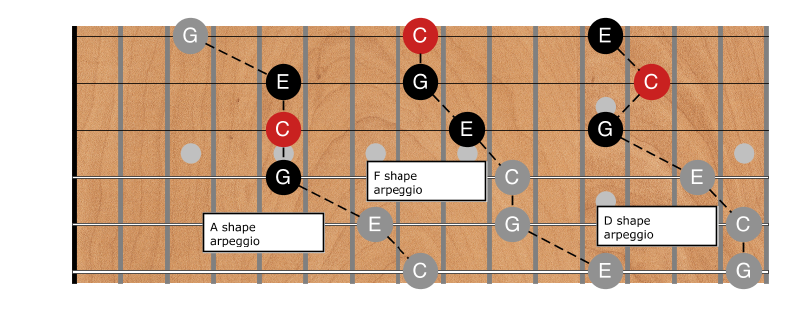
Fig 8. C Major arpeggios, FAD Triads
The triad “kernels” sort of light up in my brain.
Note where the roots are in each shape (shown in red):
The 1st string for the F shape (with an alternate on the 4th).
The 3rd string for the A shape.
The 2nd string for the D shape.
Since Rex’s FAD keeps me focused on just the top four strings, it’s easy to know which shape I want to use.
I just have to answer: Where is the root? On which string?
First or fourth string: use the F shape.
Second string: D shape.
Third string: A shape.
If you KNOW where the notes are on the fretboard you’ll find it trivial to find chord tones anywhere on the fretboard using just those three triads!
Chord fingerings with FAD
The FAD triads shown in figure 7 are only for visualizing what I want to play. I use the kernel triads to recall the full 6-string arpeggio shapes.
I can then choose to play three, four, or even five string chord shapes depend on where my hand is and what I want to accomplish.
In other words, the three triads in figure 7 are merely “hooks” or “indexes” into my memory. They are tools to assist with navigation.
99% of the time, I jut play the chords on the top four strings labeled “standard” fingerings below. Occasionally, I’ll want to grab some lower notes or don’t want to move my hand as far, and I’ll use one of the alternate fingerings:
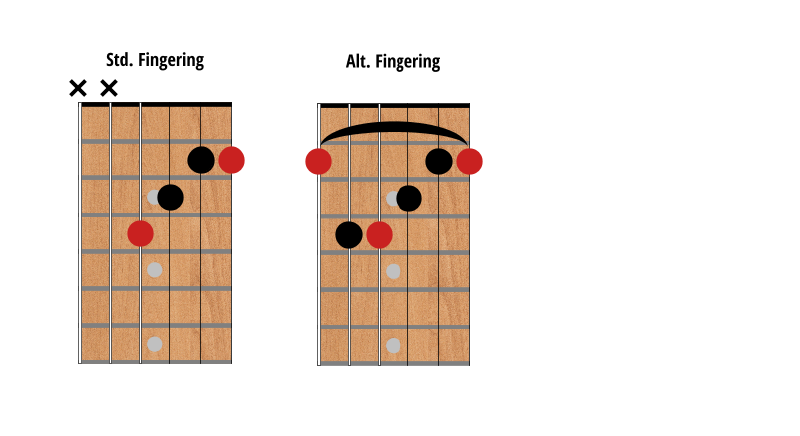
Fig 8. F-shape chord fingerings
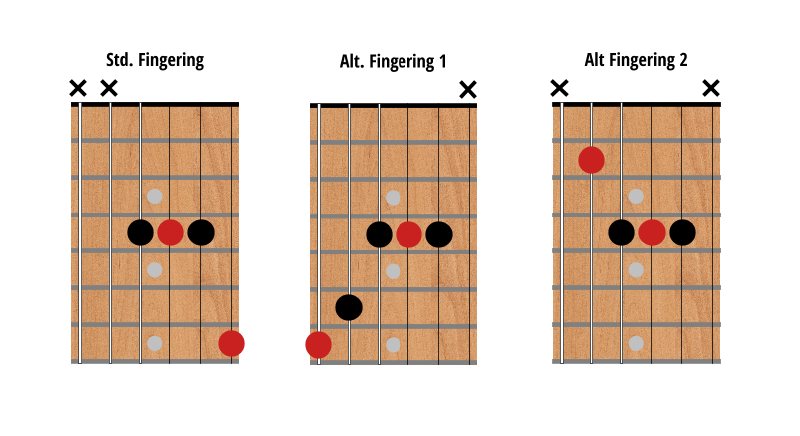
Fig 9. A-shape chord fingerings
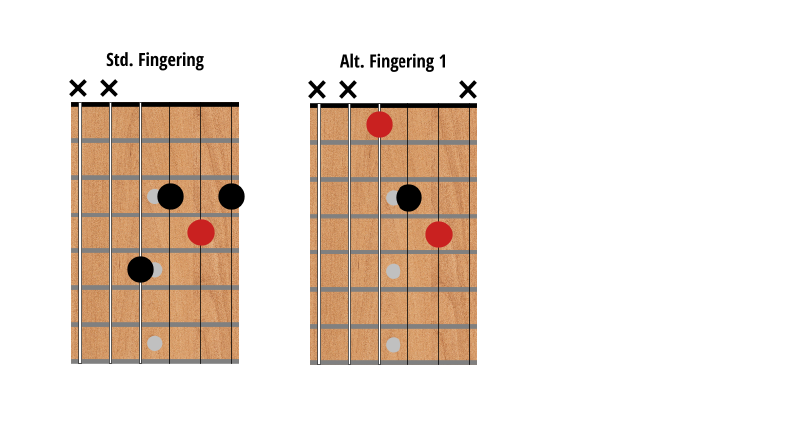
Fig 10. D-shape chord fingerings
Why I like Rex’s FAD
The value of “Rex’s FAD” to me is:
I only need to KNOW three things rather than five.
I only have to remember where the one root note is in each triad kernel (in the middle unless it’s F).
I mastered finding notes on the fretboard, so its now trivial to find chords anywhere on the neck. You have learned your note locations haven’t you?
I no longer think about shape names at all. I’d just call those chords in figure 4 F♯, B, and E major chords and be done with it.
I can play two of the shapes two different ways, depending on whether I have fingers above or below the “kernel” triad. (The F shape is only played with fingers mostly higher on the neck.)